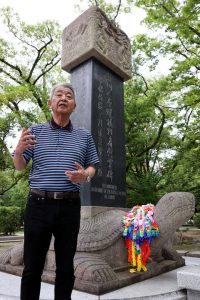Summer following conclusion of Hiroshima Summit—Did G7 leaders truly see Hiroshima? Part 5: First sitting South Korea president to visit Hiroshima
Jul. 25, 2023
President sympathizes with “double agony” suffered by compatriots
A-bomb survivors from Korean peninsula call for “nuclear abolition”
by Kana Kobayashi, Staff Writer
On May 21, the final day of the summit meeting of the G7 (Group of Seven industrialized nations) held in Hiroshima, as Ukrainian President Volodymyr Zelenskyy’s surprising attendance at the summit captured the world’s attention, another historic moment took place. As the first sitting president of that nation to do so, South Korea President Yoon Suk-yeol visited the Monument in Memory of the Korean Victims of the A-bomb, located in Naka Ward’s Peace Memorial Park, to pay respects to Korean victims of the atomic bombing.
Alongside Japan Prime Minister Fumio Kishida and his wife, Mr. Yoon and his wife offered flowers at the monument and observed a moment of silence that lasted around 10 seconds. Ten Korean A-bomb survivors and second-generation survivors resident in Japan were present at the site. The group did not have the opportunity to speak directly with the leaders, but Gan Ilbong, 86, a survivor who lives in Hiroshima’s Higashi Ward, expressed his pleasure. “It was an emotional moment because we have struggled so much due to the atomic bombing away from our home country.”
Mr. Gan, whose parents were born on the Korean Peninsula, experienced the atomic bombing when he was eight years old in the area of Kojin-machi (in what is now Hiroshima’s Minami Ward), 2.1 kilometers from the hypocenter. The horrific conditions in the city, including maggot-filled corpses and the incinerated downtown area, remain etched into his memory.
Suffered work discrimination because of nationality
Hard times continued for Mr. Gan after the war. He attended junior high and high school at night while holding down a job. Because he faced discrimination due to his nationality, he ended up changing jobs frequently. Reflecting on those days, he explained how he survived the “double agony” of being an A-bomb survivor as well as a Korean living in Japan. “It was all I could do just to make a living.”
When President Yoon arrived in Hiroshima on May 19, around 20 people, including Korean A-bomb survivors and second-generation survivors resident in Japan as well as those involved in the Hiroshima Headquarters of the Korean Residents Union in Japan (Mindan), met with the South Korea president for about 30 minutes. The group welcomed Mr. Yoon with applause, and representatives reiterated their words of welcome. President Yoon spoke and apologized to the group, saying, “Despite the fact that you have faced pain and suffering outside of our country as South Koreans, our government failed to support you.” The audience listened raptly to his words, nodding and crying.
Still unclear is the precise number of people from the Korean Peninsula who died in the atomic bombings of Hiroshima and Nagasaki after being forced to work here, to serve in the military, or because they were in dire financial straits under Japan’s colonial rule. The death toll of Koreans in the atomic bombing of Hiroshima is estimated to have been “between 5,000 and 8,000” or even “30,000.” Korean A-bomb survivors who returned to their home country after the end of the Pacific theater of World War II were for a long time excluded from aid measures for A-bomb survivors provided by Japan’s national government.
This first sitting South Korea president visit to Hiroshima was realized because Mr. Yoon had been invited to attend the expanded version of the summit meeting. His visit was of significance for providing comfort to South Korean A-bomb survivors. On May 21, alongside the leaders of other nations invited to the expanded summit, Mr. Yoon toured the Hiroshima Peace Memorial Museum and offered flowers at the Cenotaph for the A-bomb Victims.
South Korea dependent on “nuclear umbrella”
Nevertheless, South Korea has deepened its reliance on the “nuclear umbrella” provided by the United States amid continued threats by neighboring North Korea, a country that has persisted in the development of nuclear weapons and missiles. On July 18, a U.S. Navy strategic nuclear submarine, with nuclear missile capability, docked at the port city of Busan. In the capital city of Seoul, the United States and South Korea held the first meeting of the Nuclear Consultative Group (NCG), designed to provide a venue for regular joint discussions of nuclear strategy.
“I hope Japan and South Korea, two nations with many A-bomb survivors who have been forced to struggle, can work hand-in-hand to create a world without nuclear weapons,” said Kwon Joon-oh, 74, a second-generation A-bomb survivor living in Hiroshima’s Nishi Ward who serves as chair of the Committee Seeking Measures for the Korean A-bomb Victims and had the opportunity to meet with President Yoon in person. A stone monument placed near the memorial monument that the nations’ two leaders visited two months ago is engraved with a message. “We hope that the souls of those who were forced to suffer can be healed and that the A-bomb tragedy is never repeated.”
(Originally published on July 25, 2023)








